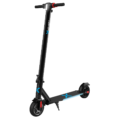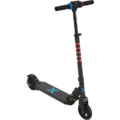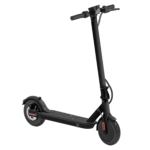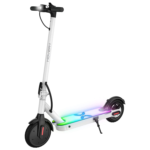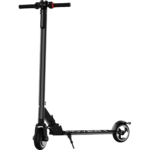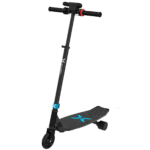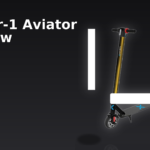- Home
- Scooters
- Electric Scooters
- Hover-1 Fade
Hover-1 Fade


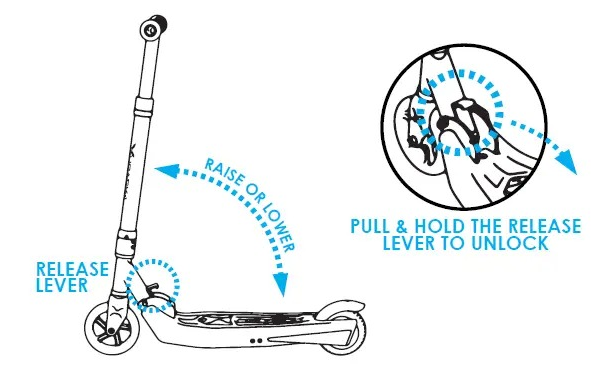
- Battery Range: 3 miles (5 km)
- Top Speed: 7 mph (11 km/h)
- Motor Power: 150 W
- Weight Capacity: 88 lb (40 kg)
- Charging Time: Not specified
- Scooter Weight: 8.0 lb (3.6 kg)
PROS
- Ultra-light 8 lb design
- Up to 7 mph kid-safe speed
- Simple rear foot brake
CONS
- Very short 3-mile range
- Low max rider weight (88 lb)
- Lead-acid battery adds weight vs. lithium
Table of contents
- What Is the Hover-1 Fade?
- How the Hover-1 Fade Works
- Key Specifications
- Design & Build Quality
- Performance Fundamentals
- Battery, Range & Efficiency
- Ride Quality & Comfort
- Braking & Safety Features
- Portability & Daily Usability
- Maintenance & Care
- Weather & Seasonal Considerations
- Hover-1 Fade vs Alternatives
- Who the Hover-1 Fade Is (and Isn’t) For
- FAQs
- Glossary
- Final Thoughts
The Hover-1 Fade is a compact, beginner-friendly electric scooter built for easy daily rides and weekend fun. It blends simple controls, colorful deck lighting, and sensible performance into a package that new riders can learn on quickly. Because it is lightweight and approachable, it suits students, short-hop commuters, and anyone who wants a low-stress way to move around town without breaking a sweat.
What Is the Hover-1 Fade?
At its core, the Hover-1 Fade is an urban kick-to-go electric scooter with a brushless hub motor in the front wheel, a 36-volt lithium-ion battery inside the deck, and a minimalist folding frame. It emphasizes predictable handling, steady braking, and easy ownership. Additionally, it adds a bit of flair: a color-changing LED deck and side accents that help you stay visible and add personality.
The Fade targets the rider who values convenience over raw speed. It’s designed to roll smoothly on paved streets, bike paths, and campus walkways. Meanwhile, its fold-and-carry design makes it practical for apartments, office hallways, and trunk transport. You won’t need advanced skills to enjoy it; you step on, push off, and thumb the throttle.
How the Hover-1 Fade Works
Electric scooters all share the same playbook, yet the details matter. The Fade keeps things simple and durable, which benefits new riders.
- Motor: A front-hub brushless DC motor provides smooth, low-maintenance propulsion. Because the motor lives in the wheel, there are no chains or belts to adjust. As you roll, magnets and coils inside the hub create rotational force. You’ll feel a gentle, linear pull from a stop and an easy push up to cruise speed.
- Controller: The controller sits between the battery and motor, acting like the scooter’s brain. When you nudge the throttle, it meters current to the motor so acceleration feels consistent. It also coordinates regenerative braking, which gently slows the scooter while recapturing a bit of energy.
- Battery: A 36 V pack (10S lithium-ion) stores energy in the deck. Capacity is tuned for short-to-medium urban rides, balancing weight and range. Furthermore, an integrated Battery Management System (BMS) monitors temperature, cell balance, and current draw for safety and long-term health.
- Throttle: A right-side thumb throttle keeps your wrist in a neutral position. Because you operate it with small thumb inputs, fine speed control becomes intuitive within minutes. The Fade also supports a steady cruise once you hold a pace for a short stretch.
- Brakes: You get dual-layer stopping: electronic regenerative braking at the front hub plus a rear mechanical disc. The e-brake smooths deceleration when you roll off the throttle; the disc adds firmer bite when you pull the lever. Together, they produce controlled stops with less fork dive and fewer skids.
In short, the Fade’s systems work together to make learning straightforward. The controls are light, the power delivery is gentle, and the braking feels reassuring.
Key Specifications
Below is a clean, easy-scan breakdown that presents key details in both metric and imperial units.
General
| Item | Value |
|---|---|
| Model | Hover-1 Fade |
| Intended Use | Urban/short-range commuting, campus, errands |
| Rider Height Range | ~4’10″–6’2″ (147–188 cm) |
| Max Rider Weight | 220 lb (100 kg) |
| Frame Material | Aluminum alloy stem and deck with polymer trims |
| Water Resistance | IPX4 splash-resistant (ride with caution in light spray) |
| Lighting | Multicolor LED deck/side accents; front LED headlight; rear LED taillight |
Performance & Power
| Item | Value |
|---|---|
| Motor Type | Front-hub brushless DC |
| Nominal Motor Output | 300 W (peaks higher briefly) |
| Top Speed (flat) | Up to 14 mph (≈ 22.5 km/h) |
| Typical Hill Grade | ~7–10% with run-up; slower on steeper ramps |
| Drive Modes | Multiple speed modes for new and experienced riders |
Battery, Charging & Electrical
| Item | Value |
|---|---|
| System Voltage | 36 V (10-series lithium-ion) |
| Pack Capacity | ~6.0 Ah (≈ 216 Wh) |
| Claimed Range | Up to 10–12 miles (≈ 16–19 km) under ideal conditions |
| Realistic Mixed Range | ~5–9 miles (≈ 8–14 km) depending on rider and route |
| Charger | 42 V DC barrel connector; UL-listed |
| Charge Time | ~4–6 hours from low to full |
| Energy Display | LED battery indicators on cockpit |
Build & Dimensions
| Item | Value |
|---|---|
| Tire Size/Type | 8.5 in (216 mm) honeycomb solid tires |
| Wheelbase | ~36 in (≈ 91 cm) |
| Deck to Handlebar | ~38–42 in (≈ 97–107 cm), depending on stance |
| Deck Size | ~17.5 × 6.0 in (≈ 44.5 × 15.2 cm) usable |
| Unfolded Dimensions | ≈ 43.5 × 17 × 45 in (110.5 × 43 × 114 cm) L×W×H |
| Folded Dimensions | ≈ 43.5 × 17 × 17 in (110.5 × 43 × 43 cm) L×W×H |
| Scooter Weight | ~32–34 lb (≈ 14.5–15.5 kg) |
| Folding Mechanism | Stem latch with safety tab |
Safety & Control
| Item | Value |
|---|---|
| Braking | Front electronic regen + rear mechanical disc |
| Traction | Solid rubber tires; puncture-proof; firm ride feel |
| Reflectors | Side/Rear reflective elements |
| Bell | Integrated thumb bell on handlebar |
| Controller Protections | BMS safeguards, over-current and thermal protections |
Features & Extras
| Item | Value |
|---|---|
| Cruise Control | Yes (holds steady speed after a brief constant-throttle period) |
| Ride Modes | Beginner / Standard / Sport |
| Kick-to-Start | Yes (helps protect the motor and adds safety) |
| Display | Simple LED indicators for speed mode and battery |
| App | Optional basic pairing on certain revisions (speed mode, light controls) |
| Lighting Effects | Color-cycling LED deck/side accents |
Warranty & Compliance
| Item | Value |
|---|---|
| Warranty | Limited manufacturer warranty (typical coverage ~90 days; check your local terms) |
| Charger Safety | UL-listed charging equipment |
| Manual & Labels | Safety guidance and maintenance schedule included |
| Legal Note | Local riding rules and age limits vary by region |
Note: Real-world performance depends on rider weight, ambient temperature, wind, tire condition, and terrain. Because battery health changes with age, range and power naturally vary over time.
Design & Build Quality
The Hover-1 Fade favors simplicity. The frame uses a square-section stem and a low, flat deck that keeps your center of gravity close to the ground. As a result, turn-in feels predictable, and quick stops don’t pitch you forward. The deck surface provides consistent grip, even when your shoes are damp. Furthermore, the deck illumination adds side visibility at night, which helps others see you.
Fit-and-finish is what you expect from a modern entry-level scooter. Panel gaps are even, the latch clicks firmly, and the cables route cleanly into the stem. Because the front motor is hub-mounted, the fork remains compact and maintenance-free. The cockpit layout is uncluttered: a central display cluster with battery bars and mode indicators, a right thumb throttle, and a left brake lever with a small bell nearby.
Most hardware is corrosion-resistant, yet you should still wipe the scooter dry after wet exposure. The folding hinge includes a secondary safety catch, which reduces accidental unlatching. The result is a scooter that feels solid when riding yet folds quickly when you reach a staircase or train platform.
Performance Fundamentals
Riders care less about brochures and more about feel. The Fade delivers calm, linear acceleration that doesn’t surprise new users. On flat ground, it eases to cruising speed within a short block. Because the motor sits up front, steering inputs remain light, and the scooter tracks straight with minimal effort.
On small hills around 7–10%, the Fade benefits from a rolling start. It climbs steadily if you carry some speed into the grade. However, steeper ramps will slow it, especially with heavier riders. That is normal for commuter-class scooters tuned for efficiency. Use a lower mode in crowded areas, then switch to a higher mode where space opens up. The controller’s response remains smooth across modes, so you won’t need to recalibrate your thumb every time.
High-speed stability depends on tire condition and road texture. Solid tires don’t squish like air-filled ones, which keeps steering precise but transmits more texture. Therefore, the Fade feels most comfortable at neighborhood speeds on clean asphalt or concrete. If your path includes bricks or patchy pavement, bend your elbows and let your knees flex; this simple stance absorbs chatter and keeps the bars calm.
Battery, Range & Efficiency
Battery math tells the story. With a roughly 216 Wh pack, the Fade optimizes for short trips rather than marathon rides. On warm days with a 150 lb rider, gentle throttle, and few stops, you can see mid-to-high single-digit miles before battery bars drop into the reserve zone. Colder air thickens battery chemistry and increases rolling resistance, so range shrinks. Headwinds and hills also tax the motor, reducing distance.
Because efficiency matters, adopt a few easy habits:
- Pre-plan stops. Roll off early and let regen slow you. You’ll conserve both energy and brake pads.
- Cruise at a moderate pace. Speeds near the middle of the scooter’s envelope yield the best miles per watt-hour.
- Keep tires healthy. Solid tires don’t need air, yet they still benefit from clean treads and intact edges. Sharp debris and curb strikes waste energy and comfort.
- Charge smartly. After rides, let the scooter cool before charging. Avoid storing the pack full or empty for weeks; target ~40–60% when parking for long periods.
Charging is straightforward. Plug the charger into the wall first, then connect to the scooter. The indicator light shows red while charging and green when full. Moreover, if you finish a short ride, there’s no need to top off immediately. Partial charges are fine and often healthier than constant 100% cycles.
Ride Quality & Comfort
The Fade rides on 8.5-inch solid tires. You never worry about flats, which is liberating. However, solids feel firmer than pneumatic tires, so road seams and small potholes transmit more feedback. This is not a flaw; it is a trade-off in exchange for zero punctures and lower upkeep. To stay comfortable, ride with soft elbows, keep your feet hip-width on the deck, and shift weight slightly to the rear over bumps.
The stem has modest flex by design, which helps soak minor chatter without feeling loose. Because the deck is low, stability is excellent during braking and slow-speed maneuvers. Over longer rides, hand fatigue stays mild thanks to light lever effort and the thumb-throttle’s small travel. On rough patches, the scooter encourages a relaxed, upright stance rather than a crouched, aggressive posture.
Noise levels remain low. The motor emits a soft hum under load, and the solid tires create a consistent, faint buzz on smooth concrete. Rattles are uncommon if you keep the latch adjusted and the visible screws snug.
Braking & Safety Features
Safe stopping is a team effort between electronic regen and the rear disc. When you roll off the throttle, mild regen kicks in, which takes the edge off speed without drama. Pull the lever halfway, and the rear rotor adds real bite. Because weight shifts forward under braking, keep your front foot square and your shoulders relaxed. The combined system keeps stops straight and predictable, even on gently damp surfaces. For deeper technique, stopping-distance tips, and setup checks, see this brake performance guide.
Lighting is bright for its class. A forward LED throws a white beam for visibility, while the rear light grows brighter under braking. The deck and side accent LEDs add visibility from oblique angles at dusk. However, you should still ride defensively around vehicles and treat lighting as a way to be seen, not as a headlight replacement on dark roads.
The Fade carries an IPX4 splash rating, which means it resists light spray. Avoid heavy rain, standing water, and pressure washers. Water can invade bearings and electrical connectors, shortening component life. After wet exposure, dry the scooter and store it indoors.
Portability & Daily Usability
Fold-and-go convenience is one of the Fade’s best traits. The hinge locks quickly, and the stem becomes a handle. Because the scooter weighs roughly 32–34 pounds, most riders can carry it up a flight of stairs without strain. You can slide it behind an office chair, tuck it under a café table, or lay it in a trunk. The deck’s low profile and flat surfaces make storage neat and simple.
Daily usability hinges on predictable controls. The accelerator behaves the same every morning, and the brake lever remains light. The display gives you just enough information to plan charging without clutter. Moreover, the kick-to-start logic prevents accidental launches if someone bumps the throttle while the scooter is at rest. In crowded spaces, set the lowest mode to keep speed in check. Then, once the path clears, click up to a faster mode.
For security, bring a compact U-lock or folding lock and secure the deck or front wheel to an immovable rack. Never leave the scooter powered on unattended, and keep the charger at home.
Maintenance & Care
Entry-level scooters shine when upkeep is simple. The Hover-1 Fade asks for only light attention if you follow a regular rhythm:
- Before every ride: Check that the folding latch is fully closed. Squeeze the brake lever and confirm solid feel. Tap the bell to ensure it’s audible.
- Weekly: Wipe the scooter with a damp cloth, then dry it. Inspect the tires for cuts or missing chunks. Confirm that stem bolts and axle nuts are snug.
- Monthly: Test brake bite at a walking pace, and adjust the cable if the lever travel grows long. Ensure the rotor remains true; minor rubs often resolve with cable fine-tuning. Check for any side play at the hinge; most latches have a small adjustment to tighten fit.
- Every few months: Inspect the deck edges and lighting strips for damage. Confirm that the charge port rubber cap seals fully. Review the owner’s manual safety items.
Because the tires are solid, you avoid puncture repair and air pressure headaches. The trade-off is to watch for wear flats if you frequently brake hard. Rotate riding zones on the tire by varying your foot stance and braking habits.
If your scooter revision pairs with a basic app, update firmware only when the battery is near mid-charge and the scooter remains still. Interrupting a firmware process risks communication errors.
Weather & Seasonal Considerations
Weather shapes range and grip. Warm, dry days give you the best performance. Cold air (below ~50°F / 10°C) reduces range because lithium chemistry slows and electrical resistance increases. Therefore, store and charge the scooter indoors during winter. Begin rides gently to let the pack warm under light load before asking for full power.
In rain and slush, skip rides whenever you can. If you must travel in a light sprinkle, slow down, brake earlier, and avoid painted lines, metal grates, and wet leaves. Solid tires can hydroplane less than smooth pneumatics, yet they still lose traction on slick surfaces. Dry the scooter after any wet exposure, and leave it at room temperature before charging.
Heat also affects battery health. On very hot days, park the scooter in the shade and avoid leaving it in a closed car. After steep hill climbs, allow a few minutes for components to cool before you plug in.
Hover-1 Fade vs Alternatives
Electric scooters fall into a few broad categories: ultra-light last-mile models, commuter all-rounders, and performance machines. The Hover-1 Fade sits near the light commuter/last-mile border.
- Compared to ultra-lights: The Fade carries a bit more motor and battery than very small last-mile scooters, which helps it feel calmer at speed and steadier on mild hills. It remains portable enough for public transit and walk-ups.
- Compared to commuter all-rounders: Mid-tier commuters often add air tires, longer decks, and larger batteries. They ride softer and go farther, but they weigh more and cost more. If you need daily 12–15 mile round trips on mixed terrain, a mid-tier commuter may suit you better.
- Compared to performance models: Performance scooters jump in power, suspension travel, and weight. They tackle steep grades and rougher paths, yet they demand more skill and space. If you ride mostly in dense areas, their extra speed may be wasted.
Where the Fade excels: short hops, quick errands, mixed multi-modal routes, and low-stress learning. It’s easy to store, easy to carry, and easy to control.
Who the Hover-1 Fade Is (and Isn’t) For
Great for:
- Students commuting across campus or between nearby neighborhoods
- New riders who prefer gentle acceleration and steady braking
- Apartment dwellers who need a compact, hallway-friendly fold
- Multi-modal travelers who combine scooter, bus, and train
- Weekend riders who value fun lighting and simple care
Not ideal for:
- Long daily round trips on hilly terrain
- Riders needing soft suspension over broken pavement
- Heavy cargo carriers who often haul backpacks and groceries
- Speed-focused enthusiasts who want aggressive performance
FAQs
1) How fast does the Hover-1 Fade go, and is that speed stable?
It reaches about 14 mph (≈ 22.5 km/h) on flat ground. Stability at that pace is calm as long as the surface is smooth and you keep a relaxed stance with soft elbows.
2) What is the realistic range in mixed riding?
Expect roughly 5–9 miles (≈ 8–14 km) with a single mid-weight rider, mild hills, and typical stop-and-go traffic. Warmer temperatures and smoother paths push range upward.
3) Can the Fade climb hills?
Yes, on modest grades around 7–10% with a bit of run-up. Steeper climbs slow it, which is normal for scooters tuned for efficiency rather than brute power.
4) Does it have cruise control?
Yes. After you hold a steady speed for a short time, the scooter maintains that pace until you brake or nudge the throttle.
5) Is the Hover-1 Fade water-resistant?
It has an IPX4 splash rating. Light spray is acceptable, but you should avoid heavy rain, puddles, and pressure washing.
6) What should I check regularly to keep it safe?
Confirm the folding latch is locked, the brake lever feels firm, and the tires are free of cuts. Periodically snug visible fasteners and wipe the scooter dry after wet rides.
7) Where can I find a concise Hover-1 Fade overview?
You’re reading one. This guide covers the essentials: design, operation, performance, care, and safety considerations.
Glossary
- Ah (Amp-hours): Battery capacity measure. Higher Ah usually means more stored energy.
- Wh (Watt-hours): Voltage × capacity; a clearer picture of total energy.
- Controller: The electronic unit that manages power flow between battery and motor.
- Regen (Regenerative Braking): Motor-based braking that slows the scooter and recovers a bit of energy.
- Stem Flex: Small, intentional give in the handlebar mast that can improve comfort over rough patches.
- IP Rating: Ingress Protection code showing resistance to dust and water (e.g., IPX4 = splash-resistant).
- Kick-to-Start: Safety feature requiring a light push before the motor engages.
- Hub Motor: Motor built into the wheel hub; low maintenance and sealed from debris.
- BMS (Battery Management System): Circuitry that protects and balances the battery pack.
- Solid Tire: Puncture-proof rubber tire that trades a firmer ride for zero flats.
- Disc Brake: Mechanical caliper grabbing a metal rotor for stronger stopping power.
- Wheelbase: Distance between wheel centers; influences stability and turning feel.
- Cruise Control: Electronic function that holds a steady speed automatically.
- UL-Listed Charger: Charger tested to meet electrical safety standards.
- Puncture Protection: Design choice (solid tires) that prevents air-loss failures.
Final Thoughts
The Hover-1 Fade doesn’t chase headline numbers. Instead, it delivers a calm, confidence-building ride wrapped in a compact frame with fun lighting and straightforward care. Because it folds quickly and weighs modestly, it fits real life—apartments, elevators, transit platforms, and small car trunks. If your daily routes are short and your priorities are simplicity, safety, and low-maintenance ownership, the Fade makes a sensible, enjoyable choice.
Specifications
General
| Model The Model specifies the exact version or name of the scooter. It helps identify its unique design, features, and specifications within the manufacturer’s product line. Knowing the model makes it easier to compare options, find compatible accessories, or look up support information. | Fade |
| Brand The Brand identifies the manufacturer or company that designs and produces the scooter. A trusted brand is a sign of quality, reliability, and good customer support. Well-known brands often have higher standards for safety, performance, and after-sales service, giving you more confidence in your purchase. | Hover-1 |
| Release Date The Release Date indicates when the scooter model was officially launched on the market. This helps you know how current the design, technology, and features are. A newer release date often means updated components, improved performance, and the latest safety or smart features. | 17 November 2025 |
| Recommended Age Recommended Age indicates the minimum age range that the scooter is designed for, based on safety, size, and ease of use. Following the recommended age helps ensure that riders can handle the scooter’s speed, weight, and controls comfortably and safely. Always check local laws and use protective gear, especially for younger riders. | +16 |
Performance & Power
| Motor Power (Wattage) What it means: The motor power, measured in watts (W), shows how strong the scooter’s electric motor is. Why it matters: Higher wattage usually means better acceleration, more torque, and improved performance on hills or rough terrain. For example, a 250W motor is good for flat city roads and light riders, while a 500W or 1000W motor provides more power for faster speeds or climbing steep inclines. | 150 W motor |
| Top Speed The Top Speed indicates the maximum speed that the scooter can reach under optimal conditions. It’s usually measured on level ground with a fully charged battery and an average rider weight. A higher top speed allows you to travel longer distances faster, but always ensure you ride within legal speed limits and your personal comfort zone for safety. | Up to 7 mph (11 km/h) |
| Battery Capacity Battery Capacity refers to the total amount of energy the scooter’s battery can store, usually measured in ampere-hours (Ah) or watt-hours (Wh). A higher battery capacity means you can ride longer distances on a single charge, reducing the need for frequent recharging. Keep in mind that actual range can vary depending on rider weight, terrain, speed, and weather conditions. | Not specified |
| Estimated Range per Charge The Estimated Range per Charge indicates the average distance the scooter can travel on a single full battery charge. This range is calculated under optimal conditions, such as flat terrain, moderate speed, and average rider weight. Real-world range may vary depending on riding style, terrain, weather, and load. A longer range means fewer recharges and greater freedom for longer trips. | Up to 3 miles (5 km) |
| Hill Climb Ability Hill Climb Ability describes the maximum incline or slope that the scooter can handle while maintaining stable performance. It’s typically expressed as a percentage or in degrees. A higher hill climb rating means the scooter can tackle steeper hills without losing too much speed or power. Actual climbing performance may vary based on rider weight, battery charge, and terrain conditions. | Not specified |
| Drive System The Drive System refers to how power from the motor is delivered to the wheels. Electric scooters typically use either a hub motor (directly integrated into the wheel) or a chain/belt drive system. A high-quality drive system ensures smooth acceleration, efficient power transfer, and low maintenance. The choice of drive system affects performance, noise level, and overall ride experience. | Not specified |
Charging & Electrical
| Charging Time Charging Time indicates how long it takes to fully recharge the scooter’s battery from empty to 100% using the standard charger provided. Faster charging means less downtime and more time on the road. Actual charging time may vary slightly depending on battery capacity, charger output, and environmental conditions. | Not specified |
| Battery Type Battery Type refers to the specific technology used in the scooter’s battery, which affects performance, lifespan, weight, and charging time. Most modern electric scooters use high-quality lithium-ion (Li-ion) batteries because they offer a good balance of energy density, durability, and low maintenance. A reliable battery type ensures consistent power delivery and longer riding ranges. | Lead-acid battery |
| Removable Battery A Removable Battery means the battery pack can be easily detached from the scooter for convenient charging and replacement. This feature allows you to charge the battery separately, swap it with a spare for extended range, or securely store it indoors in extreme weather. Removable batteries add flexibility and make it easier to keep your scooter powered up wherever you are. | Non-removable battery |
| Regenerative Braking Regenerative Braking is an energy-saving feature that converts some of the energy normally lost during braking back into battery power. When you slow down or brake, the motor works in reverse to generate electricity, which helps extend the scooter’s range and improves overall efficiency. This system also reduces wear on traditional brake components, leading to lower maintenance over time. | No |
| Lighting Lighting refers to the built-in front and rear lights that enhance visibility and safety when riding in low-light conditions or at night. Good lighting helps you see the road ahead and ensures that other road users can see you. Many scooters include LED headlights, taillights, and sometimes brake lights or side reflectors for added safety and compliance with local traffic regulations. | Not specified |
Build & Dimensions
| Scooter Weight Scooter Weight refers to the total weight of the scooter when fully assembled, including the battery. This affects how easy it is to carry, lift, and store the scooter when not in use. A lighter scooter is more portable and convenient for commuting, especially if you need to carry it upstairs or onto public transport. Keep in mind that a sturdy frame and quality components may add to the weight but also contribute to better durability and ride stability. | 8.0 lb (3.6 kg) |
| Maximum Rider Weight Maximum Rider Weight indicates the highest rider weight that the scooter is designed to safely support while maintaining optimal performance and stability. Staying within this limit helps ensure reliable acceleration, braking, and climbing ability, and it protects the frame, suspension, and motor from excessive strain. Exceeding the recommended limit may reduce performance and increase wear on components. | 88 lb (40 kg) |
| Deck Size Deck Size refers to the dimensions of the scooter’s standing platform. A wider and longer deck provides more foot space, allowing you to stand comfortably and adjust your stance while riding. A well-sized deck improves balance and stability, especially on longer rides or at higher speeds. Compact decks, on the other hand, help keep the scooter lightweight and portable. | Not specified |
| Handlebar Height Handlebar Height refers to the distance from the deck to the handlebars, which affects your riding posture and comfort. An appropriate handlebar height helps you maintain good balance, reduces strain on your back and arms, and makes steering more comfortable. Some scooters have adjustable handlebars to fit riders of different heights, while others have a fixed height for a streamlined design. | Fixed |
| Folding Mechanism The Folding Mechanism describes how easily and securely the scooter can be folded for carrying and storage. A well-designed folding system lets you quickly collapse the scooter into a compact size, making it convenient to transport on public transit, store under a desk, or fit into a car trunk. Look for sturdy latches and safety locks to ensure the scooter stays firmly in place when folded or unfolded. | Not specified |
| Dimensions Folded Dimensions indicate the size of the scooter when it’s fully folded. This measurement shows how much space the scooter will take up when stored or carried, making it easier to check if it will fit in your car trunk, under a desk, or in a closet. Compact folded dimensions are ideal for commuters who need to bring their scooter on public transport or store it in tight spaces. | Not specified |
| Material Material refers to the primary construction materials used for the scooter’s frame and key components. High-quality materials like aircraft-grade aluminum, reinforced steel, or durable composites provide strength, stability, and a lighter overall weight. A sturdy material ensures the scooter can handle daily wear and tear while maintaining safety and performance. | Not specified |
Safety & Control
| Brake Type(s) Brake Type(s) describe the braking systems the scooter uses to help you slow down or stop safely. Common brake types include mechanical brakes (like drum or disc brakes), electronic brakes, and foot brakes. Many scooters combine multiple braking systems for added safety and shorter stopping distances. The type and quality of brakes affect your control, especially when riding at higher speeds or on slopes. | Rear foot brake |
| Suspension Suspension refers to the system that absorbs shocks and vibrations while riding, providing a smoother and more comfortable ride over uneven or rough surfaces. Scooters may have front suspension, rear suspension, or dual suspension for better shock absorption and stability. Good suspension helps reduce rider fatigue and improves control, especially when riding on bumpy roads or off-road paths. | None |
| Tire Type Tire Type refers to the kind of tires the scooter uses, which directly affects ride comfort, traction, and maintenance. Common types include solid (airless) tires, pneumatic (air-filled) tires, or hybrid options. Pneumatic tires offer better shock absorption and a smoother ride on rough surfaces, while solid tires are puncture-proof and require less upkeep. The right tire type helps ensure safe handling and a comfortable ride in different conditions. | Not specified |
| Tire Size Tire Size indicates the diameter and width of the scooter’s tires, which affect ride comfort, stability, and how well the scooter handles different terrains. Larger tires generally offer better shock absorption and a smoother ride over bumps and rough surfaces, while smaller tires keep the scooter lighter and more portable. Choosing the right tire size helps ensure a balance between agility and comfort. | Not specified |
| Kickstand The Kickstand is a built-in stand that allows you to park your scooter upright when it’s not in use. A sturdy kickstand keeps the scooter stable and prevents it from tipping over, protecting it from scratches and damage. It also makes storing and accessing your scooter more convenient, whether you’re at home, work, or on the go. | Not specified |
| Water Resistance Rating Water Resistance Rating indicates how well the scooter is protected against water and moisture, usually shown as an IP (Ingress Protection) rating. This rating helps you understand whether the scooter can handle light rain, splashes, or wet roads without damage. While most scooters are not fully waterproof, a good water resistance rating adds peace of mind when riding in changing weather conditions. Always avoid deep puddles or submerging the scooter to protect its electrical components. | Not specified |
Features & Extras
| Display/Console The Display (or Console) shows important real-time information about your ride, helping you monitor your scooter’s status at a glance. Typical displays show speed, battery level, distance traveled, and riding mode. Some models also include additional features like Bluetooth connectivity, app integration, or backlighting for better visibility at night. A clear and easy-to-read display enhances safety and convenience on every trip. | Not specified |
| Ride Modes Ride Modes refer to the different speed and power settings you can choose to match your riding style or road conditions. Common modes include eco for maximum range and energy efficiency, standard for everyday balance, and sport or turbo for higher speed and stronger acceleration. Switching between ride modes allows you to customize performance, conserve battery, and ride safely in various environments. | Not specified |
| Smart App Connectivity Smart App Connectivity lets you pair your scooter with a dedicated mobile app via Bluetooth. Using the app, you can monitor real-time ride stats like speed, battery level, and range, adjust settings such as ride modes or cruise control, lock the scooter for added security, and sometimes receive firmware updates. This feature adds convenience and allows you to personalize your riding experience right from your smartphone. | No app |
| Anti-Theft System The Anti-Theft System helps protect your scooter from unauthorized use or theft. This feature can include built-in alarms, electronic motor locks, GPS tracking, or remote locking through a mobile app. A good anti-theft system provides peace of mind when parking your scooter in public spaces, adding an extra layer of security to safeguard your investment. | Not specified |
| Cruise Control Cruise Control allows you to maintain a steady speed without continuously holding the throttle. This feature makes longer rides more comfortable by reducing hand fatigue and providing a smoother, more relaxed riding experience — especially on flat, open roads or bike lanes. For safety, cruise control can usually be easily activated or deactivated while riding. | No |
| Accessories Included Accessories Included lists the additional items that come with the scooter to enhance your riding experience and convenience. Common accessories may include a charger, kickstand, bell, lights, phone holder, or carrying strap. These extras add value by making your scooter safer, easier to use, and ready to ride straight out of the box. | Scooter, charger, manual |
Warranty & Compliance
| Warranty Period The Warranty Period indicates how long the manufacturer guarantees the scooter against defects in materials and workmanship under normal use. A good warranty provides peace of mind, showing the brand’s confidence in its product quality. Always check what parts are covered, such as the frame, battery, and motor, and follow the maintenance guidelines to keep your warranty valid. | Region-dependent (kids product warranty) |
| Certifications Certifications confirm that the scooter meets specific safety, quality, and environmental standards set by recognized organizations or regulatory bodies. Common certifications may include CE, RoHS, UL, or other local compliance marks, depending on your region. These certifications ensure that the scooter is manufactured to high standards and is safe and legal to use in your country. | Region-dependent compliance |


